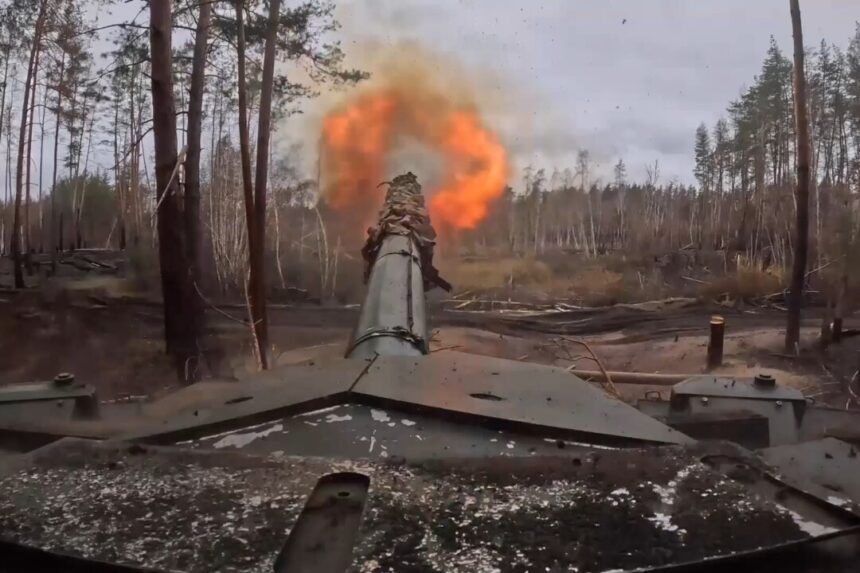Russian forces in Donbas are currently advancing at a much faster pace than they did throughout 2023, as reported by a Washington think tank. The focus has been on the Kursk region in western Russia, where Ukrainian forces are struggling to maintain control ahead of ceasefire talks. However, Russian forces have been steadily advancing through the eastern Donbas region, capturing numerous towns and villages and hundreds of square miles of territory. Ambassador Matthew Bryza stated that the conflict in Donbas, now in its third year, is no longer a stalemate, although he believes Russia is not winning the war. Russian President Vladimir Putin claimed in a televised address on Nov. 21 that Russian forces were advancing along the entire contact line in Ukraine, contradicting Western politicians who have called the war a stalemate. The Institute for the Study of War (ISW) recently concluded that ongoing Russian gains in Donbas show that the war in Ukraine is not stalemated. Since early September, Russian forces have significantly increased their advances, capturing over 425 square miles of territory. This marks a much quicker rate of advancement compared to the entirety of 2023. Russian forces are currently targeting Toretsk, a key Ukrainian stronghold in north-central Donetsk, following the capture of nearby towns. The town is under siege, with Russian forces using various weaponry to advance quickly. The ISW assessment highlights the increasing fluidity of the frontline in Donetsk, indicating ongoing Russian advancements. In addition to Donbas, Russian forces are also approaching Kupiansk, the administrative capital of Ukraine’s northeastern Kharkiv region. Despite claims by Russia’s defense ministry of capturing certain areas, the situation has not been independently confirmed by Kyiv officials. The conflict began in 2022 when Russia invaded and annexed several regions, leading to ongoing fighting as Ukraine seeks to regain lost territories with the support of Western allies. Former President Donald Trump’s reelection has raised speculation that the war may soon end, as he has pledged to push for a resolution, although details remain scarce. Mike Waltz (R-Fla.), Trump’s new national security adviser, emphasized the importance of bringing the conflict to a “responsible end” in an interview with Fox News. He stressed the need to determine the parties involved, whether an agreement or armistice is possible, and the framework for a potential deal.
In response to Waltz’s comments, a Kremlin spokesman indicated Moscow’s readiness to engage in talks aimed at resolving the conflict. Putin outlined Moscow’s conditions for ending the conflict, including the withdrawal of Ukrainian forces from territories claimed by Russia and assurances that Ukraine will not join NATO.
Ukrainian President Volodymyr Zelenskyy rejected these terms, calling them “unacceptable for Ukraine and suicidal for Europe.” However, he recently expressed doubts about the possibility of reclaiming Crimea through military means, suggesting a diplomatic approach.
On Nov. 26, Sergey Naryshkin, head of Russia’s foreign intelligence service, highlighted the need for any cease-fire arrangement to reflect the realities on the battlefield. He emphasized Russia’s military strength and strategic initiative in the conflict.
Despite the challenges, there is speculation that Russia may need to withdraw its troops from certain regions, including Kherson and Zaporizhzhia. Former U.S. ambassador Matthew Bryza believes that Ukraine is unlikely to relinquish territory and that concessions will be necessary from both sides to reach a resolution.
The conflict escalated as Ukrainian forces launched an offensive into Russia’s Kursk region in early August, leading to territorial gains. Russian troops have since recaptured some of the territory, prompting Kyiv to consider using it as leverage in cease-fire negotiations.
Zelenskyy expressed confidence that Putin aims to push Ukrainian forces out of the Kursk region by a specific deadline. Ukrainian forces have utilized advanced missile systems to target Russian locations, complicating Russia’s efforts to regain control of Kursk.
Bryza noted the strategic value of territory in Kursk as a bargaining chip for Kyiv and emphasized the importance of compromise in reaching a resolution. He highlighted the need for both sides to make concessions to achieve a mutually beneficial outcome.
The article includes insights from various sources and highlights the complexities of the conflict, underscoring the challenges and potential paths toward a resolution. Can you please rewrite this sentence?
Source link





